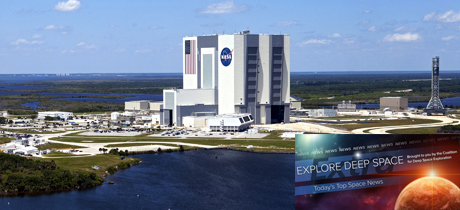In Today’s Deep Space Extra… A U.S. led lunar orbiting habitat could become a deep space departure point for human explorers as well as a gateway for a return to the moon’s surface. Opposition grows to 2019 budget proposals to end NASA’s oversight of the International Space Station in 2025 and cancel the WFIRST space telescope. The re-established National Space Council meets for a second time Wednesday at NASA’s Kennedy Space Center.
Human Space Exploration
How NASA is going to use a lunar outpost to launch us into deep space
ScifyWire (2/17): NASA’s Lunar Orbital Platform Gateway (LOPG), featured in NASA’s proposed 2019 budget — could re-open the lunar surface to scientific scrutiny, human exploration and commercial activities. The gateway could also serve as a departure point for human deep space destinations, including Mars.
Spacewalking astronauts finish Canadarm2 work at breakneck speed
Spaceflightinsider.com (2/16): NASA’s Mark Vande Hei and Japan’s Norishige Kanai worked quickly on Friday to finish up a multi-spacewalk overhaul of the International Space Station’s Canadian robot arm. A key aging component, a mechanical hand removed during the start of upgrades in October, will be returned to Earth for refurbishment.
Turning our back on the International Space Station
The Hill (2/18): In an op-ed, George Mason University planetary scientist Michael Summers questions a 2019 White House budget proposal that would end NASA operations of the International Space Station in 2025. The Station is crucial to studies of the health impacts of spaceflight on astronauts, writes Summers. Under the proposal, NASA will transition its human exploration focus from low Earth orbit to deep space. Low Earth orbit activities would transition to the private sector.
In rugged Negev desert, Israeli scientists plan for mission to Mars
Times of Israel (2/19): At Israel’s Ramon crater, a very Martian desert like setting, a half-dozen of the nation’s scientists spend four days simulating Red Planet exploration. One goal of the exercise was to boost Israel’s young space industry.
Space Science
Astronomers will fight to save WFIRST space telescope from being axed
Space.com (2/15): The American Astronomical Society is vowing to oppose efforts to terminate development of NASA’s Wide Field Infrared Space Telescope (WFIRST), as proposed in the 2019 fiscal year budget the Trump administration presented to Congress on February 12. “We cannot accept termination of WFIRST, which was the highest-priority space-astronomy mission in the most recent decadal survey,” AAS President-elect Megan Donahue said in a statement. The high ranking comes from the National Academy of Sciences for WFIRST’s capabilities to unravel dark energy and seek out bio signatures in extra solar planets.
Martians welcome: Studies find people cheer — not fear –the possibility of alien life
Science (2/17): Findings presented before the annual meeting of the American Association for the Advancement of Science suggest most people would welcome the discovery of life beyond Earth. The Arizona State University study examined responses to three announcements, the 1996 discovery of possible tiny fossilized microbial structures in a Martian meteorite; the 2015 finding of Tabby’s star and speculation over the presence of an artificial structure; and the 2017 announcement of a star with multiple rocky planets orbiting in the habitable zone.
Mars orbiter on precautionary standby status
NASA/Jet Propulsion Laboratory (2/16): NASA’s very productive Mars Reconnaissance Orbiter (MRO) has been placed in temporary standby mode while engineers assess a power issue. MRO, which has been orbiting Mars since 2006, serves as an important communications relay for other missions on the Red Planet’s surface as well as a source of high resolution imagery of the planet’s surface.
A 6-year-old tells NASA to make Pluto a planet again: ‘You need to fix this problem for me’
Washington Post (2/17): Ireland’s Cara O’Connor, 6, is urging NASA to help restore distant Pluto’s status to full-fledged planet. Just over a decade ago, Pluto was reclassified as a dwarf planet. Cara, who would like to become an astronaut, added, “you need to fix this problem for me.”
Exoplanet-hunting satellite arrives in Florida for April launch
Spaceflightnow.com (2/16): NASA’s Transiting Exoplanet Survey Satellite, or TESS, has reached NASA’s Kennedy Space Center to await a launch planned for no sooner than April 16. TESS is to take on the extra solar planet search began by NASA’s Kepler space telescope, which was launched in 2009. TESS is to search for planets much closer to Earth than has Kepler.
Andromeda galaxy not bigger than Milky Way after all
USA Today (2/15): The neighboring Andromeda Galaxy, once thought to be larger than the Milky Way, really is not, according to a new assessment by astronomers.
Other Stories
NASA certifies Falcon 9 for science missions
Space News (2/16): In response to a NASA certification process, the SpaceX Falcon 9 rocket has been authorized to launch many of the agency’s science mission satellites.
Major Space Related Activities for the Week
Major space related activities for the week of February 19-23, 2018
Spacepolicyonline.com (2/18): The recently re-established National Space Council, chaired by Vice President Mike Pence, is slated to meet for a second time since standing up in October 2017, this time at NASA’s Kennedy Space Center on Wednesday. Regulatory reform is an anticipated topic. Possible web cast details could be forthcoming. Also, in Washington, a Planetary Science Advisory Committee session is planned for Wednesday through Friday. Topics include a new 2019 NASA budget initiative to nurture commercial lunar landers, rovers and science instruments. Congress is not in session this week.

